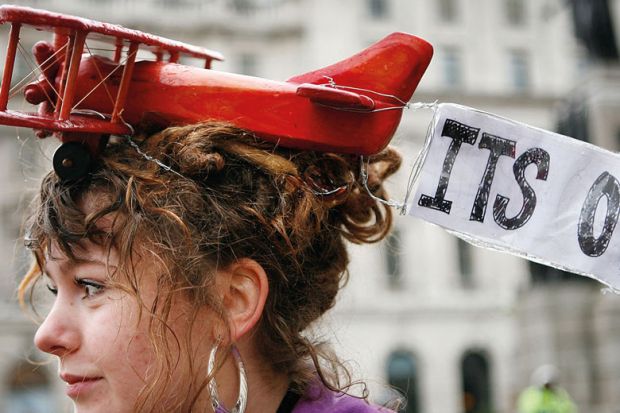Universities must take “urgent deliberate action” such as setting institutional carbon budgets and making emissions a key factor in project evaluations if they want to maintain gains on cutting flying made during the pandemic, leading researchers have warned.
Without such steps, there is a “risk” that rates of air travel seen before the Covid crisis “will resume” despite plenty of “target-setting” by universities, according to the “Academic Aeromobility Post-Covid 19” project, which is supported by the Tyndall Centre for Climate Change at the University of Manchester and the Economic and Social Research Council-funded Centre for Climate Change and Social Transformation (Cast).
In a new report, the Tyndall Centre and Cast suggest a series of actions for the sector, including using institutional carbon budgets, adding emissions assessments to research evaluation and compensating academics who avoid using planes.
One specific example on compensation includes allowing unused travel funds “to be transferred into funding for staff time, research expenses, communication, or investing in virtual work”.
THE Campus views: Universities aren’t walking the walk on sustainability – not even close
More support should also be given to help academics make better use of international journeys and travel that they do make, for example by combining visits during one trip and giving them equipment enabling them to work better on trains.
On research evaluation, the report says that carbon emissions should be considered as a key part of project proposals, alongside traditional factors such as income and impact.
The report also emphasises the improvements needed in terms of the data reporting and monitoring on air miles, but Claire Hoolohan, a research fellow at the Tyndall Centre, said taking actual actions that reduce flying needed to take priority.
“My concern is that monitoring and reporting is time-consuming, and risks coming at the expense of action when there are things that can be done right now to start reducing emissions,” she said.
As a “bare minimum”, these actions could include measures such as compensating researchers if they chose to travel by train even if it is more expensive so they are not “rapidly burning through their research funds if travel by land is more expensive than a flight”.
Dr Hoolohan said institutional carbon budgets were also potentially “useful” in limiting flying to trips where it was really necessary, although she was less convinced by the case for carbon budgets for individuals.
“You could spend considerable time and money developing these, to achieve little more than the ability to point fingers at individuals in institutions where there is no mandate for flying less. I am not convinced that blame is what is needed.”
She also said that institutional leadership, in setting an example to staff, was vitally important given that it became “an empty gesture if you have leaders saying, ‘don’t fly’, and they themselves do”, but also so that other staff did not use their leaders’ choices as an excuse not to fly less.
The report also says that efforts to cut flying in academia also need to take into account how air travel may have benefited more privileged academics and institutions in the past, and that “remaining air travel should prioritise the inclusion of peoples, regions and institutions that have fewer opportunities to be present”.
For example, Dr Hoolohan said, “some institutions with less funding or in more remote locations might need the space to grow their emissions a little bit and some others might need to decarbonise faster to allow that to happen”.
POSTSCRIPT:
Print headline: ‘Set institutional carbon budgets to cut flying and support rail travel’
Register to continue
Why register?
- Registration is free and only takes a moment
- Once registered, you can read 3 articles a month
- Sign up for our newsletter
Subscribe
Or subscribe for unlimited access to:
- Unlimited access to news, views, insights & reviews
- Digital editions
- Digital access to THE’s university and college rankings analysis
Already registered or a current subscriber? Login










